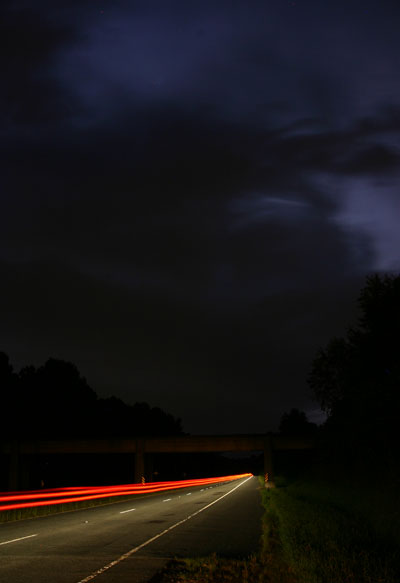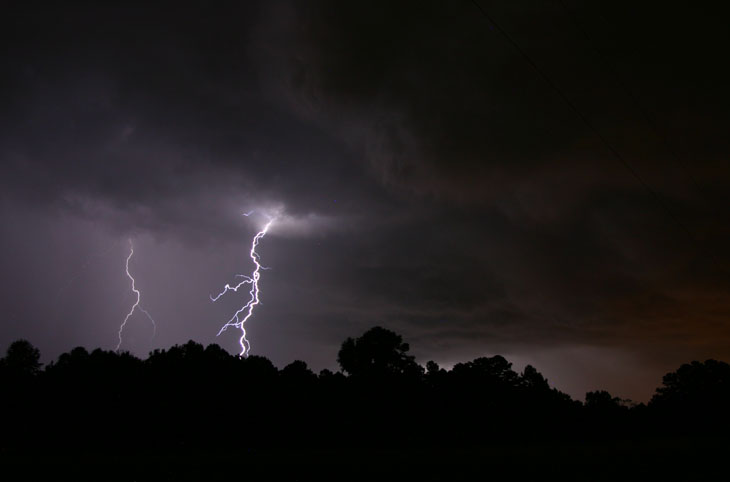 As several separate thunderstorm cells moved through tonight, I was watching the inordinate amount of electrical activity lighting up the sky like a disco strobe, and figured I should be doing something about it. I haven’t pursued much lightning photography in my current location because it’s remarkably difficult to find a good setting. This area of central NC is loaded with trees, and electrical storms tend to stay close to the horizon, so wide open spaces are much better, preferably with some kind of foreground interest (lakes, lone trees, abandoned houses, mad scientist’s lairs.) Even though I’ve actively scouted for such things, I haven’t found many.
As several separate thunderstorm cells moved through tonight, I was watching the inordinate amount of electrical activity lighting up the sky like a disco strobe, and figured I should be doing something about it. I haven’t pursued much lightning photography in my current location because it’s remarkably difficult to find a good setting. This area of central NC is loaded with trees, and electrical storms tend to stay close to the horizon, so wide open spaces are much better, preferably with some kind of foreground interest (lakes, lone trees, abandoned houses, mad scientist’s lairs.) Even though I’ve actively scouted for such things, I haven’t found many.
This time around I elected to use a road, and drove out to a nearby connecting spur with a train bridge. Enough traffic to get some vehicle lights, but not too much to crowd up in long exposures while waiting for a decent bolt. The flaw in this plan was not facing quite the right way, and getting only residual light without visible discharges. I wasn’t ready to give up yet, so I packed up and tried to find a place that would let me see more of the cells. It took a bit of driving, but I located an open field facing the right way and bordered by a wandering treeline
Now, a few words about lightning photography. Like meteor showers, what is almost guaranteed to happen is that you will see a brilliant display, either just outside of the camera’s field of view, or while you are looking through the view finder framing the image right before actually tripping the shutter. This did of course happen tonight as I realized there was more activity off to the right and re-aimed the camera, seeing but not capturing a lovely strike right in a gap in the treeline.
Something that can be nice to capture is the shape and texture of the clouds lit up by lightning, especially from within, but this is actually a different exposure than for lightning itself. In this case, I was working with mostly hidden discharges, so getting anything at all in an image required f5.6 at ISO 200, and exposures longer than 30 seconds with lots of visible activity therein. This is a little tricky; with the right light, you get lovely cloud detail, but this often takes multiple flashes to achieve, and if the front or cell is moving fast but there’s too much time between discharges, you overlap faint cloud exposures when the clouds have moved, producing more of a hazy effect than getting detail. I usually advise no more than three bright flashes before you close the shutter and take another photo.
Then there’s the more immediate problem of getting a brilliant bolt in the frame, exactly as desired, when the exposure is set for clouds:

If you look close just to the right of the white area, you can barely see the branches off of the main bolt, which is hidden within that glare. But don’t the clouds look nice?
This happened three times, partially because I don’t trust the LCD to tell me what I captured and ignored the washout, thinking it would resolve better on a proper monitor. In my defense, I was working with distant, dim bolts, hidden flashes, and the occasional piercing strike like this one that was bright enough to make me blink and left an after-image on my retina. And yes, I did change settings to try and capture such bright blasts, which is when they stopped coming and all of those subsequent exposures have virtually nothing in them at all. This is storm-chasing; you can’t make it work for you, you can only try to plan and hope luck favors you.
And sometimes, it does.

I’m especially pleased with the glow from the cloud right at the top of the bolt – never captured that before. Now all I have to do is get activity like this tied in to a nice foreground, especially one I can get to quickly when I see the right conditions rolling in.




















































What’s up Dear, are you truly visiting this web site regularly, if so afterward you will definitely get fastidious experience.
Word